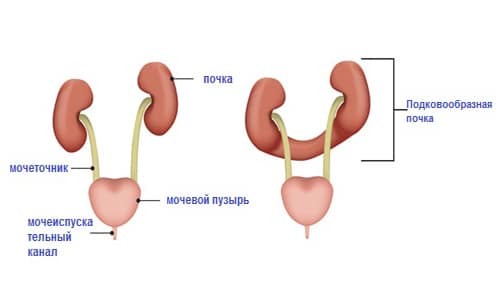Although the kidneys are hidden deep inside the body, they can be damaged by traffic accidents, sports training, unsuccessful falls andetc. Regardless of the cause, the bruise of the kidney requires medical examination and consultation, since it refers to very serious injuries that can cause irreversible waspsozhneniya. In case of kidney trauma of this nature, organ damage occurs on the ribs and vertebrae, which contributes to multiple hemorrhages in the parenchyma, can damage the calyx. Therefore, qualified treatment is necessary.

How is the bruised injury of
manifested? Contusion of the kidney is considered to be a closed type of injury and manifests a bright specific symptomatology, so it can be easily diagnosed after an injury almost immediately. The main signs of such damage are, as a rule, a triad of symptoms:
- Hematuria;
- Bright pain syndrome;
- Puffiness in the lumbar region.
Blood in the urine, according to the severity of the injury, can manifest with varying intensity. In some patients, urine may acquire a red tint, while in others, blood spots are found only when tested. Gematurical symptoms can occur after a few days or weeks after the injury or immediately after the injury. This symptom is not necessary, since sometimes there are no blood impurities in the urine at all. This happens if hemorrhage occurs in the cellulose near the kidney or when blood clots clog the ureteral lumen. If the proper treatment is not provided, and the hematuria proceeds long and intensely, then anemia develops, due to blood loss.
Most often, bruised kidney damage is the result of a sports injury, a fight, a fall from a height or a car accident.
Pain syndrome, accompanying a bruise of the kidney, covers the abdomen, waist, irradiates in the groin, can be piercing or blunt, sharp and intense. The manifestation begins with an average morbidity, which gradually intensifies, increasing intensity. The duration of the pain syndrome is about 1.5-2 weeks, then it gradually decreases until it disappears completely.
The area of the bruised kidney is usually swollen, a hemorrhage and a hematoma occur. Puffiness is localized on the side of the lesion in the lumbar region, although it can spread to the corresponding hypochondrium. Swelling occurs due to the formation of a hematoma or when blood is accumulated in retroperitoneal and pericarp cellular tissue( and urine accumulates in the event of a violation of renal integrity).
In addition to the triad of characteristic features, the patient may have other symptoms:
- Severe weakness;
- Nausea and vomiting syndrome;
- High temperature;
- Blushing of the mucous membranes and skin;
- Bloating;
- Decrease or increase in pressure in the arteries;
- Palpation causes an attack of pain and muscle tension;
- Urinary disorders;
- Significant deterioration of the condition, possible development of shock;
- Intestinal paralysis;
- Symptoms of pain when tapping the lower ribs with the side of the palm.
If a kidney injury is combined with another trauma or accompanied by complications, then the symptomatology is supplemented with signs of an acute abdomen, which indicates an inflammatory process that developed in the abdominal cavity. Often, such a renal injury is accompanied by pulmonary or hepatic injuries, fracture of the ribs.
Causes of damage to the
The cause of the kidney injury are:
- Blows into the localization of the kidney, in the lower back;
- Falling on a hard surface or object;
- Consequences of road accidents, air crashes and other transport accidents;
- Long squeezing;
- Various types of household damage.
Because of the lower location, the kidney located on the right is more likely to be injured than to the left.
The risk of getting a kidney injury is much higher in children, because they are more active and mobile. In addition, the likelihood of injury of this kind is high in individuals who have pathologies of the organs of the urinary system such as dystopia, L- or horseshoe kidney, urolithiasis, renal omission or hydronephrosis. In these conditions, even a slight external impact can lead to organ damage.
Degree of severity of injury
According to clinical symptoms, several degrees of severity of such lesions are distinguished:
- Mild - characterized by minor changes in the general condition of the affected person, no symptoms of hematoma, slight and short-term hematuria, mild pain syndrome, home treatment;
- Medium - the patient has a pronounced hematuria, the blood pressure drops, the pulse becomes frequent, there can be a significant decrease in the amount of urine released, even a complete absence of it. In the area of the affected kidney, the hematoma is clearly visible, the pain syndrome is insignificant, often of a wandering nature, giving off in the penis, scrotum, groin. For this degree, inpatient treatment is recommended;
- Severe - A similar condition is characterized by shock, a bright pain syndrome in the lumbar region, accompanied by a prolonged growing macrogemuria. An extremely dangerous condition requiring urgent hospitalization of the victim for the purpose of immediate treatment and prevention of irreversible consequences.
Methods for diagnosis and treatment of kidney damage
Effective diagnosis requires laboratory and instrumental methods of investigation. The victim gives blood and urine tests, undergoes a radiographic examination, which allows to determine the presence of hematoma, the extent of damage, and helps to detect the accompanying lesions in time( if any).Additionally, ultrasound, angiography, cystoscopy, urography, magnetic or computer tomography, etc. can be prescribed.

Renal injuries, as a rule, do not require surgical intervention, their treatment is limited mainly to conservative methods. In the first place is appointed 1,5-2-week bed rest. The first 24 hours after injury, it is recommended to apply cold to the affected area. Usually, preparations of anti-inflammatory, hemostatic and analgesic action are prescribed. To prevent the development of infectious processes, antibiotic therapy is indicated.
If it is not possible to determine the extent of the lesion or there are significant lesions, if the conservative therapy is ineffective or if there is a large area of dead tissue of the kidneys, surgical intervention is indicated.
To relieve the load from the affected body, it is recommended to reduce the level of fluid intake. After 3 days, you can start treatment with the help of physiotherapeutic procedures that will have a resolving and anti-inflammatory effect. The most effective and often used procedures are: electrophoresis, laser treatment, magnetotherapy and UHF.With the help of such procedures, the hematoma and swelling will dissolve, which will significantly shorten the period of rehabilitation and accelerate recovery.
With a pronounced hematuria or a delay in urine, the victim is catheterized. In addition to the drinking regime, it is necessary to exclude any physical effort. Within a few weeks, any physical strain is completely contraindicated.
Possible complications of
Kidney bruises are almost always accompanied by additional injuries to nearby organs. Frequent complications are intestinal or pulmonary injuries that cause a shock in the victim. In addition, there may be a detachment of the legs of the vessel, ureter or pelvis, for which there is often a lack of hematuria.
Warning! Bruised renal injuries can be complicated by peritonitis, which, if not done, leads to death. Therefore, qualified assistance to the victim should be ensured in the nearest time after an injury.
One of the dangerous complications is the kidney rupture, which occurs due to direct damage directly to the kidney. This often occurs with a stroke, a strong squeezing or bruising. In this situation, the organ is clamped between the ribs and the lumbar vertebrae, while the pressure of blood and urine increases, a hydrodynamic effect occurs, which causes the kidney to burst.
Timely assistance and adequate therapy will help to preserve the functional capabilities of the affected kidney, which plays an important role for the body.



